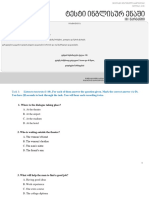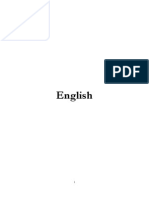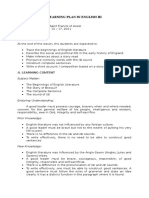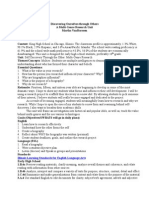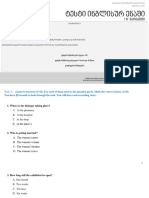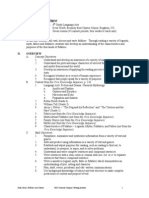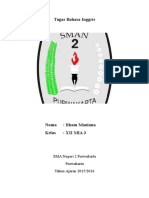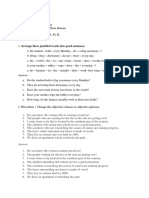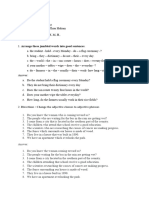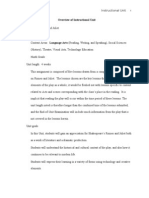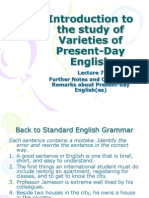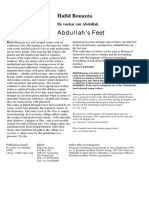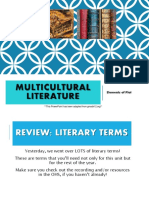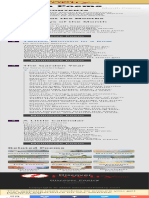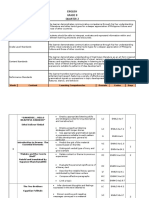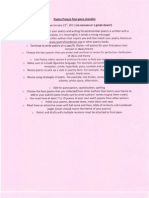Unit 1: The Researched Essay: Part 1: Stimulating Ideas
Unit 1: The Researched Essay: Part 1: Stimulating Ideas
Uploaded by
وليد طهOriginal Title
Copyright
Available Formats
Share this document
Did you find this document useful?
Is this content inappropriate?
Copyright:
Available Formats
Unit 1: The Researched Essay: Part 1: Stimulating Ideas
Unit 1: The Researched Essay: Part 1: Stimulating Ideas
Uploaded by
وليد طهCopyright:
Available Formats
Unit 1: The Researched Essay
Part 1: Stimulating Ideas
Exercise 2 B (pp. 4–5)
1. To achieve this goal, I focused on three points: the content of my essays, correct grammar, and
advanced-level vocabulary.
The three points are content, grammar, and advanced-level vocabulary.
2. Body paragraph 1 focuses on essay content.
3. Body paragraph 2 focuses on grammar.
4. Body paragraph 3 focuses on vocabulary.
5. The writer has become more confident and realizes the importance of academic writing skills.
Exercise 3 (p. 6)
Answers will vary.
1. Hook: Today there are more social networking accounts than there are people on the planet.
It gives the readers a sense of the enormity of social networking, which they probably participate in
themselves.
2. Social networking allows people to share ideas with friends and family everywhere. It connects people
in ways that were never possible in the past. By showing how widespread networking is, readers
become more aware of the importance of being cautious.
3. Still, users of these sites should be cautious. Social media can be dangerous. The essay will be about
how one can protect oneself from the dangers of social media.
4. the dangers of social networking
5. the need to be careful when using social media
Exercise 4 (p. 7)
Answers will vary.
Body Paragraph 1
1. I discovered that the content of the writing required for my college courses was different from the
content I had used in high school.
© Oxford University Press 1
2. In high school, writing focused more on personal experiences such as family and friends. In college it
was necessary to research the essays and write analyses about literature, politics, and science. These
details provide evidence of the differences in content for writing in high school and college.
3. b
Body Paragraph 2
1. I realized that I had to improve my understanding of grammar to write for college.
2. The writer had problems with run-on sentences, fragments, and verb-tense consistency. These are all
considered grammar issues.
3. a
Body Paragraph 3
1. I soon realized that much of my academic writing required sophisticated vocabulary.
2. The writer used slang and abbreviations. Using a dictionary and thesaurus allowed the writer to
include more advanced vocabulary. Slang and abbreviations are part of conversational speech and
advanced vocabulary is necessary for college writing.
3.a
Exercise 5 (p. 8)
1. 3
2. Academic writing requires critical thinking skills, an understanding of the topic, research, high-level
vocabulary, and correct grammar.
3. d
Part 2: Understanding Assignments and Planning Research
Exercise 1 (p. 10)
1. Comparing a book to its movie version
2. The audience are readers of a movie magazine.
3. Style and Format: double-spaced, using a 12-point Times New Roman font and a 1 inch margin
Exercise 2 (p. 11)
1. Comparison-contrast essay
© Oxford University Press 2
2. The signal words compare, similar, and different suggest that this will be a comparison-contrast essay.
Exercise 3 (p. 11)
1. arguing, in favor, against, defend, agree, counter, objections, convince, position
2. Argumentative essay
Exercise 4 (p. 12)
Answers will vary.
Exercise 5 (p. 13)
Primary Sources: autobiographies, diaries, oral histories, email, museum exhibits, scientific magazine
articles
Secondary Sources: encyclopedia articles, scientific magazine articles, textbooks, email, museum
exhibits
Exercise 6 (p. 14)
Answers will vary. Examples:
1. Internet, library, documentaries
2. Reliable sources come from respected authors, and publications that are documented and are
relatively recent. Unreliable sources may be anonymous and/or come from non-professional writers.
3. reliable sources include historical records, scholarly journals, university publications, and websites
from respected institutions.
4. make a list of the titles, sources, authors, dates, and URLs
Part 3: Unit and Coherence
Exercise 1 (pp. 15-16)
Having my friends and family together at my wedding was an amazing experience. I had not seen
some of my aunts, uncles, and cousins for many years. My cousin Tom lives in London, where he works
as an engineer. My mother was born in Spain, and my father was born in Indonesia, so my relatives are
scattered all over the world. (1) I really like traveling, and I have been to Europe and Asia to visit
© Oxford University Press 3
relatives. Although my family tries to get together for important occasions, this was the first time
everyone could attend. I felt so honored that it was my wedding that brought us all together. It was also
important to introduce my friends and my new husband to my relatives. All these years, none of my
friends had met my relatives. (2) Developing good friendships takes a lot of work. Watching my family,
friends, and new husband all dancing, laughing, and having a wonderful time together will stay in my
memory forever.
The band we hired played music that the guests loved, and we danced for hours. (3) My original
guest list had over 200 people, but I had to cut it down to 150. It was difficult finding a group that could
play all the diverse styles that my husband and I wanted at the wedding. Most bands specialize in one or
two different kinds of music. However, these musicians really knew all types of music—from 1940s jazz
and swing, to salsa, merengue, and even tango. (4) My brother was once in a band. In short, there was
music to suit everyone’s tastes. (5) I loved the singer’s beautiful blue dress. (6) It was incredible. Even
my grandparents danced all night.
Exercise 2 (p. 17)
1. a, c, d
2. a, b, d, e
Exercise 3 (p. 18)
2. b
3. a
Exercise 4 (p. 19)
2. Learning a foreign language takes a lot of patience and effort. Moreover, it helps to have a good ear.
3. The college student was told to revise her essay at third time. Nevertheless, she has still made great
progress with her writing skills.
4. John Steinbeck, a famous American author, wrote many books concerning the human condition. For
example, his novel The Grapes of Wrath dealt with the problems of the Great Depression.
5. Academic writing requires standard grammar, sophisticated vocabulary, and proper organization. In
contrast, electronic text messages use abbreviations, symbols, and slang.
6. Nowadays research is often done on the Internet. Previously, important information was stored on
special film called microfiche.
© Oxford University Press 4
Exercise 5 (p. 20)
Answers will vary. Examples:
A. If you want to conduct a survey, first develop a questionnaire. Next, it is necessary to interview
participants. Finally, you need to examine all the interviews and analyze the data you have collected.
B. If you want to learn Spanish, the most important thing is to take a Spanish class. The second priority is
to practice speaking Spanish with friends. Then you should visit a Spanish-speaking country.
Exercise 6 (p. 21)
2. they
3. we
4. us
5. they
6. us
Exercise 7 (p. 22)
2. As a teenager, I reported on school events, edited articles for the high school newspaper, and
published some of my stories.
3. Some of the rewards of being an author are learning about historical events, researching the lives of
famous people, and discovering facts about yourself.
4. Attending workshops on writing has taught me how to receive criticism, become a more focused
writer, and take more risks.
Part 4: Editing Your Writing
Exercise 1 (p. 23)
2. I felt very confident because I had spent a long time practicing.
3. Since it was my graduation, I bought a beautiful new outfit.
4. Although the ceremony was very long, nobody was bored.
5. We went out for a fancy meal after the ceremony ended.
© Oxford University Press 5
6. My family took a lot of photographs which I still enjoy looking at.
Exercise 2 (p. 24)
2. RO
3. C
4. RO
5. C
6. RO
Exercise 3 (p. 25)
2. Jabra Ibrahim Jabra translated many books and poems into Arabic, and his literary criticism has
enlightened his audience.
3. Isabel Allende wanted to chronicle the founding of Santiago, Chile, so she wrote Inez of My Soul.
4. Jane Austen’s original version of Pride and Prejudice was written when she was only twenty years old,
yet it was not published for almost two decades.
5. Jhumpa Lahiri writes about Indians living far from home, and she won the Pulitzer Prize for her book
Interpreter of Maladies.
6. Writers often use autobiographical information to write fiction, or they adapt the background of
other people for their stories.
Exercise 4 (p. 26)
2. Because Umberto Eco was knowledgeable about the Medieval period and philosophy, he was able to
write the novel The Name of the Rose.
3. Although René Prudhomme was an engineer by profession, he won the first Nobel Prize for Literature
for his poetry and essays.
4. Many of Tolstoy’s epic novels have been made into movies since they have unforgettable characters.
5. When Gabriel García Márquez gave up his law studies, he actively pursued a career in writing.
Exercise 5 (p. 27)
Answers will vary. Examples:
2. When I visited her, she showed me photos of her vacation.
© Oxford University Press 6
3. Because she had a demanding job, she never had time to visit with friends.
4. Since I was her favorite, I always got a special gift.
5. After she got married, she started working downtown.
Exercise 6 (p. 28)
While I was visiting China, I experienced experience a special kind of warmth from the people I (1)
came come in contact with. I was always aware of their special quality of friendliness. I (2) had have the
unique experience of being in Beijing on the night
the Chinese (3) won win their bid to host the 2008 summer Olympics. On that night, I (4) was am one of
a million and a half people who poured into the streets to express their joy and gratitude. I walked with
them and (5) shook shake hands with as many people as
I could while I sang out the words: “gong xi ni ba” (congratulations). My words (6) were are always met
with big smiles and enthusiastic handshakes. Those parents with kids on their shoulders, teenagers, and
many others (7) felt feel as if the rest of the world was welcoming them into the global community. Now
I wish them the best, and I hope to return one day. If you take a trip to China, you will experience the
same kind of hospitality.
Review: Putting It All Together
Exercise 1 (p. 29)
1. European and Indian music
2. comparison-contrast
3. Researching the origins, characteristics, rhythm, tone, and instruments used in both musical traditions
4. six pages, double-spaced, using a 12-point Times New Roman font and a one-inch margin
Exercise 2(p. 29)
Primary Sources: marriage licenses, documentaries, surveys, photographs, magazine articles,
screenplays
Secondary Sources: biographies, newsletters, magazine articles, documentaries
Exercise 3 (p. 30)
1. Difficult life-changing experiences become the memories that stay forever in our minds.
© Oxford University Press 7
2. We have to learn to balance the positive and negative effects that these situations have on us.
The day after I finished my first year at college, I had one of these life-changing experiences.
3. A mishap on my way to a job interview at an international bank taught me an important lesson.
4.“a mishap on my way to a job interview at an international bank
5. taught me an important lesson
Exercise 4(p. 30)
a. 4
b. 1
c. 7
d. 3
e. 5
f. 2
g. 6
Exercise 5 (p. 31)
A. I was in a rush to get there, (1) so I decided to take a taxi. The traffic was so horrible that the
driver was in a bad mood. (2) When he He closed the door, my new skirt got caught. I tried desperately
to pull it out, but it ripped. I thought about asking the driver to stop, (3) but
I was too embarrassed to say anything. Although I was very upset (4) , . I tried to be calm. The ride was
much longer than I expected, (5) and the air conditioning was not working. I did not want anything
negative to block my mind (6) . I was eager to have this job. I wanted to
have a good interview and make a strong impression (7) , since .Since I learned in school that first
impressions are the most valuable.
B. Finally when I arrived at the bank, I (1) looked look at my skirt. The torn hem was hanging and
was covered with dirt. Once inside, I (2) went go into the ladies room. I tried to wash my skirt and hold it
together with a safety pin. A few minutes later, I was in the waiting room when the secretary (3) called
call me. I was embarrassed and afraid that I would not get the job because of my sloppy appearance.
The most interesting part was that the manager asked me what (4) happened happen. When I (5) told
tell her the story, she started to laugh. She (6) couldn’t can’t stop. She wanted to ask me something
about myself, but she (7) kept keeps on laughing. Now I was sure I would not get the job. She said, “I
will never forget this. I never thought that I (8) would will have such a good time today. You know, when
you have to interview a lot of people in one day, it can become very boring.” Despite this ordeal, she
© Oxford University Press 8
assured me that I had the right qualifications, and in the end she offered me the position.
Exercise 6 (p. 32)
1. We never know when a negative experience can end up being a positive influence on our lives.
2. d
Exercise 7 (p. 32)
1. them
2. it
3. she
4. it
5. mine
6. me
7. us
8. This
Exercise 8 (pp. 33–34)
1. Sometimes when essays are written too quickly the sentences do not flow naturally. Therefore, you
should always read your essay out loud to make sure it does.
2. The sonnets of Shakespeare always rhyme. In contrast, modern poetry usually uses free verse that
does not rhyme.
3. Writing a good play requires a strong story line. Moreover, you need realistic dialogue and believable
characters.
4. William Shakespeare wrote comedies as well as tragedies. For example, The Taming of the Shrew and
A Midsummer Night’s Dream both have happy endings.
5. Word-processing programs can check grammar and spelling. Nevertheless, a good writer should not
depend on these tools.
Exercise 9 (p. 34)
1. A few years ago, I went to China to research a book, meet some old friends, and visit the famous
temples.
© Oxford University Press 9
2. One day we toured the Ming Dynasty gardens, walked through the narrow streets, and visited the
Great Wall.
3. I ate with chopsticks, sampled spicy foods, and drank exotic teas.
4. The Chinese are famous for creating silk screens, painting lacquer boxes, and inventing calligraphy.
5. I enrolled in a Chinese culture class where I learned how to write a few characters, speak a few words,
and recognize the different tones of the language.
© Oxford University Press 10
Unit 2: Comparison-Contrast Essays
Step 1: Stimulating Ideas
Exercise 3 (p. 39)
1. F
2. F
3. F
4. T
5. F
Exercise 4 (p. 39)
Answers will vary.
1. The journal concluded that medical students can improve their observational skills by looking closely
at art.
2 By observing patients closely doctors can form conclusions without depending on expensive medical
tests.
3. The viewer has opportunity to look at a painting for as long as they want to discover all the details
from large to small.
4. He observed that students wrote about their experiences with patients in a more caring and detailed
way.
5. Other humanities courses being offered at medical schools are playwriting, poetry, acting, and
philosophy.
Step 2: Brainstorming and Outlining
Exercise 1 (p. 41)
1. You will compare and contrast two photographs. how two photographs are similar and different
2. photography magazine The publication is a photography magazine.
3. comparisons, differences, compare, contrast, share, common, alike, different
4. block or point-by-point style
© Oxford University Press 11
Exercise 2 (p. 42)
Comparison: similar, share, common, both, alike
Contrast: conversely, differ, different
Exercise 3 (p. 42)
Answers will vary. Examples:
Points of comparison for photographs on page 36:
Points of Comparison Mother and Daughter Father and Son Fixing a Similarities
Flying Kite bicycle
Subject mother and daughter father and son parent and child
relationship
Activity playing learning both activities are
outdoors
Mood playful serious both are nurturing
Exercise 4 (p. 43)
Answers will vary. Examples:
A. Audience: professional photographers, students of photography, amateur photographers who are
trying to improve their pictures.
Purpose: to show how photographs can express a variety of moods depending on how they are taken,
to show how to capture the excitement of a child in motion
B: 1. between formal and casual
2. They will understand some of the main elements of photography such as lighting, mood, texture,
composition, and contrast.
3. The readers will expect to learn who took the photos and what elements of the photos are the most
striking and memorable. They might expect to learn about the themes depicted in each photograph.
Exercise 5 (pp. 43-44)
Answers will vary.
The way he is instructing his son is very reassuring.
The young boy looks on with a patient expression.
© Oxford University Press 12
Exercise 6 (p. 45)
Answers will vary.
Exercise 7 (p. 47)
Answers will vary. Example:
The writer interprets the photos as being revealing of children’s honest moods.
Exercise 8 (p. 50)
A. Answers will vary.
1. The boys in Village School are sitting up straight, not touching each other, and there is no movement
or communication. In Children’s Puppet Theatre, the children are not in rows. They are leaning against
each other, putting their heads on shoulders, and bunched together.
2. In Village School the light is dark, which creates a serious mood. In Children’s Puppet Theatre, the light
is natural since the children are outdoors. This creates a more relaxed and fun mood.
3. The expressions of the boys shows dignity and individuality, whereas the faces in the puppet show
delight and amazement without inhibition.
B.
1. Looking at children in different settings, one can see the honesty of their expressions.
2. In both photographs, children are staring at something, but the light, expressions, and body language
differ greatly across the two photographs.
3. light, expression, and body language.
4. block
5. Similarities: Both are about children. The personalities and individuality of the children attract the
viewers. Both focus on children’s faces.
Differences: one is light, the other is dark; one is still, while the other is full of movement.
Step 3: Developing Your Ideas
Exercise 1 (p. 51)
Answers will vary. The writer suggests that the children’s faces draw an emotional response.
Exercise 2 (p. 53)
© Oxford University Press 13
A. 1. The 3 points are basically the same: the light, the facial expressions of the subjects, body language,
and spatial positioning.
2. In Village School the light has a ghostlike quality and the clothing is somber. The boys looked
concerned and worried, maybe because the teacher is strict.
In Children’s Puppet Theatre there are different shades and textures of clothing, the mood is
spontaneous, with one boy covering his ears and another raising his arm, so viewers can almost imagine
the puppets they are watching.
B: 1. Although both photographs display a transparency of feeling, the light, the facial expressions of the
subjects, body language, and spatial positioning are different.
2. point-by-point
Exercise 3 (p. 54)
1. on
2. for
3. by
4. of
5. in
6. to
Exercise 4 (p. 54)
Answers will vary.
1. The mother is standing by the ocean.
2. The young girl is holding the string of the kite on the right side of the photo.
3. The kite is flying above the beach.
4. The father and son are kneeling next to the bicycle.
5. The bicycle is in front of the boy and his father.
Writing Process Step 4: Editing Your Writing
Exercise 1 (p. 58)
2. NR Henri Cartier-Bresson, who was a very famous photojournalist, took photographs of real-life
situations.
© Oxford University Press 14
3. R The photographs that were taken by Lewis Hines depict children working in factories.
4. R Many of the photographs that were taken by Manuel Álvarez Bravo were of inanimate objects.
Exercise 2 (p. 58)
2. Photographers who are photographing outdoors should not take pictures in the direction of the sun.
3. Ansel Adams took photographs that portrayed beautiful scenes in nature.
4. Photographs that are digital can be transferred from one document to another.
5. Telephoto lenses that make objects appear closer are good for photographing wildlife.
6. Photographs that are taken with film cannot be easily manipulated.
Exercise 3 (p. 59)
2. The Japanese, who created anime, have contributed to the film industry.
3. The digital camera, which allows people to send photos over the Internet, is used worldwide.
4. Louis Daguerre, who developed the diorama, was a French inventor. / Louis Daguerre, who was a
French inventor, developed the diorama.
Exercise 4 (p. 60)
2. There are many photographs in the book whose sizes have been changed.
3. Richard Avedon, whose pictures were of famous celebrities, was a world-renowned portrait
photographer.
4. Yosuf Karsh, whose photographs of Winston Churchill brought him international fame, was born in
Armenia.
5. Galleries whose exhibits are very controversial attract large crowds.
6. Katsuchika Hokusai, whose painting is one of Japan’s most famous, lived in the 19th century.
7. Frida Kahlo, whose paintings were often self-portraits, was injured as a young adult.
Exercise 5 (p. 61)
For anyone thinking of photography as a career, there are many alternatives. For those whose who
ambition is to be where the action is and who are not afraid of taking risks, photojournalism provides
many thrilling possibilities. However, you may find yourself in a forest fire that could be life-threatening.
Do you like to work in the outdoors? Then wildlife photography is a job (1) that who captures animals in
© Oxford University Press 15
their natural habitat. If creating posters, magazine layouts, and brochures in a large corporation sounds
interesting to you, there is advertising photography. Law-enforcement photographers shoot crime
scenes, (2) which who help police solve important cases. Sports photographers, (3) whose their job is to
freeze one perfect moment in time, often need to take hundreds of photos in quick succession to get
the desired shot. Fashion photography, (4) which who may seem glamorous to some people, is really
focused on selling clothing and can be very competitive. Do you ever wonder how restaurant menus can
make the French fries look better in the picture than on your plate? Then you might want to take
pictures of food. However, taking pictures is not as easy as baking bread. Taking a photograph is like
painting a picture. It requires skill, creativity, and an eye for detail.
Review: Putting It All Together
Exercise 1 (p. 63)
1. on
2. by
3. for
4. with
5. of
6. in
Exercise 2 (p. 63)
Answers will vary.
1. The cinematographer who is best known for special effects is George Lucas.
2. I broke my camera lens that was for my new camera.
3. The camera case that was bought in Italy was stolen.
4. Petra was crowded with people who were all taking pictures at the same time.
5. Reporters who take pictures of celebrities invade people’s privacy.
Exercise 3 (p. 64)
1. Nobuyoshi Araki, who is one of the most famous modern Japanese photographers, was born in Tokyo.
2. The camera obscura, which was made from a box with a small pin hole opening, was a type of
primitive camera.
© Oxford University Press 16
3. Alfred Stieglitz, who was married to the famous painter George O’Keefe, worked hard to make people
accept photography as an art form.
4. The Polaroid camera, which was invented by Edwin Land in 1946, produced instant photographs.
5. The first practical process of photography was invented by Daguerre, who was born in 1787.
Exercise 4 (p. 65)
1. The man whose camera was stolen filed a police report.
2. The woman whose bag was lost lives in Istanbul.
3. The local 24-hour photo shop, whose promotional advertisements enticed lots of customers, has a
booming business.
4. The $500 prize went to the young photographer whose subject matter was her cat.
5. The students whose applications were turned down were advised to reapply in the spring.
6. Quang-Tuan Luong, whose photographs have been shown on television, has visited all the national
parks in the United States.
7. The woman whose artwork sells for high prices lives in a small village.
Exercise 5 (p. 66)
The camera, (1) which was invented in 1837, has had many different professional and personal uses.
One of the earliest professional photographers was Julia Cameron, (2) whose who objective was to
make photographs the way a painter would create a painting. These photographs looked like the
portraits (3) , that were painted then. Mathew Brady, who was the greatest photojournalist of the Civil
War period (4), informed the public about the realities of war. Photojournalism was also used to depict
life during the Great Depression. For example, photographers like Dorothea Lange took emotional
photos of the dust storms in Oklahoma, (5) which whose displaced families from their homes. Photos
have become a necessity for families (6) who they want to chronicle the milestones in their children’s
lives. Photos, (7) which are an essential part of any wedding, are cherished by families around the world.
© Oxford University Press 17
Unit 3: Cause-and-Effect Essays
Step 1: Stimulating Ideas
Exercise 2 (p. 73)
Answers will vary.
Being rich and having a lot of luxuries didn’t seem to be important to people. The simple things in life
were the top priority and going out and just enjoying those things.
Exercise 3 (p. 74)
1. F
2. F
3. T
4. T
5. T
Exercise 4 (p. 74)
Answers will vary.
1. While his peers spent money on fraternities and parties, Mighty invested in the stock market. He
searched for answers on his own.
2. He made a documentary while traveling around the country asking people from many different
backgrounds what they thought happiness was.
3. Mighty concluded that people do not need material wealth to be enjoy life. People need to live life to
its fullest.
4. Answers will vary.
Step 2: Brainstorming and Outlining
Exercise 1 (p. 76)
1. causes or effects of an emotional, psychological, or physical condition
© Oxford University Press 18
2. Answers will vary.
3. a popular health magazine
4. reasons, consequences, outcomes and at least one quotation from a reliable source
Exercise 2 (p. 77)
Causes: motive, grounds, reason, promote, intention
Effects: affect, consequence, outcome, impact, result, implication
Exercise 5 (p.78)
A. Answers will vary.
B. 1. This essay will need to be formal.
2. The audience will have some general information related to the health field.
3. Answers will vary.
Exercise 7 (p. 81)
2. “Be careful what you water your dreams with,” suggests the Chinese philosopher Lao Tzu. “Water
them with worry and fear and you will produce weeds that choke the life from your dream. Water them
with optimism and solutions and you will cultivate success.”
3. On the topic of acquiring knowledge, Doris Lessing explains, “That is what learning is. You suddenly
understand something you’ve understood all your life, but in a new way.”
4. “Research is to see what everybody else has seen,” claims the Nobel Prize winner Albert Szent-
Györgyi, “and to think what nobody else has thought.”
5. According to Maxim Gorky, “Happiness always looks small while you hold it in your hands, but let it
go, and you learn at once how big and precious it is.”
6. “We tend to forget that happiness doesn’t come as a result of something we don’t have,” Fredrick
Koeing states, “but rather of recognizing and appreciating what we do have.”
7. The Persian poet Hafiz once said, “Ever since happiness heard your name, it has been running through
the streets to trying to find you.”
Exercise 8 (p. 82)
Answers will vary.
© Oxford University Press 19
2. Tina Adler says, “Feeling happy generally goes along with feeling confident, optimistic, and energetic,
all great traits for finding success.”
3. According to Phil Brown, “The verdict is in: Wealth does not make us happy.”
4. “The secret is here in the present,” suggests Paulo Coehlo. “If you pay attention to the present, you
can improve upon it.”
5. “The self is not something one finds,” claims Thomas S. Szasz, “it is something one creates.”
Exercise 9 (p. 84)
Answers will vary.
better relationships professionally, socially, and personally; better health; the ability to cope with the
many difficult decisions that life presents
Exercise 10 (p. 85)
1. Hook: Albert Camus once said, “Happiness is not a state to arrive at, rather, a manner of traveling.”
A quotation catches the reader’s attention and gets them thinking about the topic.
2. A positive outlook can help you be happy and change the outcome of your life.
3. It can enrich your relationships, improve your health, and guide you through some of life’s greatest
challenges.
4. Body Paragraph 1: A positive outlook leads to happiness in professional, social, and personal
relationships.
Body Paragraph 2: Having a positive outlook also results in good health.
Body Paragraph 3: Finally, people with positive outlooks are stronger and more capable of confronting
difficult situations.
5. Edward Hoffman suggests that people should become aware of when they experience positive
moments at work. If they can increase the number of these positive experiences, their jobs can become
more enjoyable.
6. Body paragraph 2 explains how a positive attitude can lead to good health. Dr. Wong’s quotation
states the consequences of having a negative attitude. This leads to an increase of stress hormones,
which will result in serious health problems. Therefore, Dr. Wong is providing evidence to show what
will happen if a person doesn’t have a positive attitude but rather a negative one. This strengthens the
topic sentence.
7. The quotation is indented because it is longer than four lines.
© Oxford University Press 20
8. People with positive outlooks are able to face life’s challenges better than individuals who have
negative attitudes. Also, students who are optimistic are more apt to seek help from their professors as
compared to students who are unhappy.
9. The introduction and conclusion both state that a positive outlook will improve relationships, lead to
good health, and help individuals face life’s problems.
Step 3: Developing Your Ideas
Exercise 1 (p. 86)
Answers will vary.
encouragement and support from families, keeping motivated and working really hard, staying focused
on your goals
Exercise 2 (p. 88)
1. Some college students are overwhelmed with all the assignments they are required to complete for
their courses. The demanding workload may cause the student to feel insecure and frustrated.
2. A student will succeed in college if they have family support, high motivation, and realistic academic
goals.
3. The quotations, which are from reliable professionals, reaffirm the writer’s point of view.
4. Students who are focused save time and money. Students who are not focused may have to change
their major or even drop out of college.
5. Answers will vary.
6. Answers will vary.
Exercise 3 (p. 89)
2. c
3. a
4. c
5. a
Exercise 4 (p. 90)
© Oxford University Press 21
2. Since people are receiving better medical treatment, they are living longer. / People are living longer
since they are receiving better medical treatment.
3. Because orchestras are trying to attract a younger audience, reduced rates at concert halls are
available for many high school students. / Reduced rates at concert halls are available for many high
school students because orchestras are trying to attract a younger audience.
4. Since research has shown that exercise reduces stress, more and more individuals are exercising. /
More and more individuals are exercising since research has shown that it reduces stress.
5. Since readers obtain more up-to-date information from the Internet, newspapers and magazines are
losing subscribers. / Newspapers and magazines are losing subscribers since readers obtain more up-to-
date information from the Internet.
Exercise 5 (p. 91)
2. As a result of the high pollen count, my allergies are very bad this season.
3. Because of my excellent work, I received the highest grade in the class.
4. Due to the destructive fire, the building had to be demolished.
5. Due to the great need for nurses, many students are entering the profession.
6. As a result of the building of the Suez Canal, ships are able to travel faster from the west to the east.
Exercise 6 (p. 92)
2. The fire caused major damage to the school auditorium; consequently, we will have the performance
in town hall.
3. The economy began to improve; as a result, many people bought new homes.
4. Airlines have cut back services; as a result, flights no longer provide meals.
5. The reviews were great; therefore, the theater added more performances.
6. The exam was challenging; therefore, many students failed.
7. Cell phones are convenient and economical; as a result, many people have cancelled their home
service.
Step 4: Editing Your Writing
Exercise 1 (p. 95)
Answers will vary.
© Oxford University Press 22
2. If you study hard, you should pass the test.
3. If you get a roommate, you can share the rent.
4. If you go to bed early, you will wake up refreshed.
5. If you read more, you will increase your vocabulary.
Exercise 2 (p. 96)
2. If I owned a car, I wouldn’t travel by bus.
3. If people didn’t watch a lot of TV, they could read books.
4. If I knew how to cook, I would open up a restaurant.
5. If I became the prime minister, I would give money to the poor.
Exercise 3 (p. 96)
Answers will vary.
2. I would buy a beach house if I had more money.
3. If people receive better health care, they will live longer.
4. I would learn a foreign language if I could go back to school.
5. If homeowners used solar energy, they would save money on their heating bills.
Exercise 4 (p. 97)
If you like liked music, think about taking a music appreciation course. If you
(1) would have any talent in that direction, you may want to join a choir. I joined a choir two years
ago, and I enjoy it very much. I know that if I didn’t have my rehearsals, I (2) would will be very
unhappy. I look forward to working with a conductor, learning challenging pieces, and singing with a
group. If I (3) miss missed a rehearsal, I feel a little depressed. Even if we work on a difficult piece, I (4)
would find the challenge exhilarating. If music is not the hobby for you, you should (5) find found one
that can bring you happiness. If you do, you (6) will would not be sorry.
Review: Putting It All Together
Exercise 1 (p. 98)
1. for
© Oxford University Press 23
2. of
3. on
4. to
Exercise 2 (p. 98)
1. According to an old adage, “Laughter is the best medicine.”
2. Norman Cousins says, “Laughter is a form of internal jogging.”
3. “Let us be grateful to people who make us happy,” says Marcel Proust. He continues, “They are the
charming gardeners who make our souls blossom.”
4. “Most people are about as happy,” states Abraham Lincoln, “as they make up their minds to be.”
Exercise 3 (p. 98)
1. “Remove the road blocks as you come across them,” suggests Master Jin Kwon. “Otherwise you will
have to climb a high mountain.”
2. Jalal ad-Din Rumi says, “Let the beauty of what you love be what you do.”
3. “My humanity is bound up in yours,” claims Desmond Tutu, “for we can only be human together.”
4. According to Demosthenes, “Small opportunities are often the beginning of great enterprises.”
Exercise 4 (p. 99)
1. b
2. a
3. b
4. c
Exercise 5 (p. 99)
1. The construction industry is thriving since there is a high demand for new housing. / Since there is a
high demand for new housing, the construction company is thriving.
2. Because of fierce competition for jobs, many young adults go to college. / Many young adults go to
college because of fierce competition for jobs.
3. Second careers are more common because people are living longer. / Because people are living
longer, second careers are more common.
© Oxford University Press 24
Exercise 6 (p. 100)
1. Microwaves are time saving; therefore, people are cooking less.
2. Crime rates are high; consequently, more police patrol the streets.
3. Globalization is increasing; as a result, English has become a more popular language.
4. Shopping malls are huge; consequently, consumers have more choices.
Exercise 7 (p. 100)
Answers will vary.
1. If you work hard, you should succeed in your career.
2. If you work at a job you like, you can accomplish more in less time.
3. If you travel around the world, you will learn about new cultures.
4. If you purchase tickets on line, you may save money.
Exercise 8 (p. 101)
Answers will vary.
1. If I played an instrument, I would join an orchestra.
2. If we had a long semester, we would have less vacation time.
3. If I married a movie star, I would live in Hollywood.
Exercise 9 (p. 101)
Today people work long hours and have too many responsibilities; as a result, they have very little
leisure time. If people spent more time with family and friends, they
(1) would will be happier. Often parents do not have enough time to spend with their children.
Therefore, young children do not receive the parental attention they need. If parents (2) had have more
home time, they could play games with their children and participate in more school activities. If parents
(3) spent spend more time with their children (4) , children would do better in school. Furthermore, if
workers had more leisure time, they (5) could can go on more family vacations. Teenagers (6) would
have had more time to communicate with their parents if they did not have so many responsibilities. If
leisure time (7) increased increase, the family unit would be stronger, and society as a whole would
benefit.
© Oxford University Press 25
Unit 4: Argumentative Essays
Step 1: Stimulating Ideas
Exercise 3 (p. 108)
1. F
2. T
3. F
4. F
5. F
6. T
Exercise 4 (p. 108)
Answers will vary.
1. He is the first person to be charged with the crime of movie piracy, and other arrests may follow.
2. Its function is to protect intellectual property internationally.
3. They are losing large profits and are afraid they won’t survive.
4. Answers will vary.
5. Answers will vary.
Step 2: Brainstorming and Outlining
Exercise 1 (p. 110)
1. a topic for which you have a strong opinion; Answers will vary.
2. Convince readers to support your opinion. It should be convincing enough to change people’s
opinions.
3. solid reasons, facts, reliable outside sources
© Oxford University Press 26
Exercise 2 (p. 111)
A. 1. opinion, argue, in favor of, against, defend, disagree, position, refute, counter-arguments,
convince, support
B. Answers will vary.
Exercise 3 (p. 112)
1. to
2. that
3. that
4. for
5. of
Exercise 4 (p. 112)
Answers will vary.
Exercise 5 (p. 113)
A: Answers will vary.
Audience: The audience is readers of a national newspaper. They will be concerned with issues facing
the country; They will have strong ideas about contemporary issues; They will be interested in reading
about both sides of an issue before they support a position.
Purpose: to convince readers that the position I have taken is the strongest position; to make readers
consider an issue they might not know anything about and make them think about its importance in
today’s society. to provide strong evidence to make readers rethink their viewpoint
B. Answers will vary.
1. The essay is for a national newspaper, so it will be formal.
2. They will probably have a considerable amount of information since they are regular readers of a
national newspaper. However, it might be an issue they haven’t yet considered.
3. I want them to believe that my argument is stronger than anything they have read and reconsider
their position on the issue.
© Oxford University Press 27
Exercise 7 (p. 115)
Summary:
“. . . they just don’t realize it is wrong.”
“. . . students are used to getting information easily off the Internet.”
Exercise 8 (p. 115)
b
Exercise 9 (p. 116)
A. The historian Doris Kearns Goodwin is struggling to save her reputation after she admitted plagiarism.
Ms. Goodwin, one the most popular and esteemed historians in America, has been vilified on editorial
pages throughout the land. In happier times, (1) Ms. Goodwin was a Pulitzer prize-winning chronicler of
the Roosevelts and the Kennedys. . . . (2) Her problems stem from the revelation that she lifted several
passages of her 1987 bestseller, The Fitzgeralds and the Kennedys, from other authors.. . . (3) She
announced paperback copies of her book would be shredded and that her publishers, Simon and
Shuster, would issue an edition that acknowledged the lifted passages. Ms. Goodwin also paid Ms.
McTaggart some money. . . . Public television said she would take a break from the Newshour With Jim
Lehrer program. The same day the University of Delaware withdrew an invitation for her to speak.
B. Answers will vary. Example:
According to Robert Cornwell’s article in The Independent, a famous author and historian recently lost
credibility when she plagiarized from her sources. The publishers had to reprint the book with an
apology, and the author lost a position on a prestigious television program.
Exercise 10 (p. 117)
The rules refer to academic policies regarding plagiarism, social rules of trust and the respect for the
rights of others and the laws against taking someone else’s work and calling it your own.
Exercise 11 (p. 119)
A.
© Oxford University Press 28
1. Students have busy schedules and find it difficult to finish their work so they do it to save time.
2. He/she finds their behavior irresponsible.
3. It destroys trust, can damage the relationship between student and teacher and student and
classmates. Furthermore it can prevent students from realizing their own potential.
4. Answers will vary.
5. Answers will vary.
6. The first summary shows the negative repercussions from plagiarism. The second summary backs up
the counterargument giving an explanation of why students engage in this type of illegal activity. This
summary suggests that students are unaware that it is illegal. Yes, the summaries are effective in
supporting the writer’s point of view.
B.
1. Hook: A common question asks, "Why recreate the wheel?" This question suggests that if work has
already been done by someone else, there is no reason to redo it. Yes, it is effective because it makes
the reader think.
2. Plagiarism is against the law and it is irresponsible, too.
3. d
4. Body paragraph 1: Plagiarism is a violation of trust. Body paragraph 2: Plagiarism is against the law.
They give very good reasons for why plagiarism is wrong.
5. Opposing ideas: Students don’t have time. Argue Against: Not a solution. Students should try to
negotiate the deadline.
6. The writer’s purpose is to convince university authorities and students that plagiarism is wrong. The
writer makes this very clear in the conclusion.
7. The conclusion gives 3 strong reasons. The third reason, damages own potential is reiterated in
various ways. Summary: The conclusion reminds readers that plagiarism damages relationships and
breaks school rules. The writer also reiterates that students lose out on their own education and
academic success when they plagiarize.
Step 3: Developing Your Ideas
Exercise 1 (p. 122)
The writer thinks that cable companies charge too much for the service, and that the fact they have a
monopoly makes it unfair.
© Oxford University Press 29
Exercise 2 (p. 123-124)
A. Answers will vary.
1. The first reason the writer gives is that cable companies charge too much money for the service.
2. The quality of satellite service is inferior, and many buildings do not allow tenants to use
satellite dishes.
3. Cable companies say they are losing money and that getting free cable is against the law.
4. Answers will vary.
B.
1. I believe that viewers have a right to use free, unauthorized cable service. It gives the opinion that
people should not pay for cable service.
2. The background explains that many people use cable, but that it is a burden and there are no good
alternatives.
3. costs, facts about why satellite service is not a viable alternative for many people, one cable company
in each area creates a monopoly
4. The summary presents the counter-argument and does not support the writer’s position.
5. Cable companies will lose paying customers and go out of business.
Exercise 3 (p. 125)
2. C
3. C
4. R
5. R
6. R
Exercise 4 (p. 125)
Answers will vary.
Exercise 5 (pp. 126-127)
2. Once an invention is patented, only the owner can make, sell or distribute the product. However,
anyone else who wants to profit from this item must get permission from the owner. / Once an
© Oxford University Press 30
invention is patented, only the owner can make, sell or distribute the product; however, anyone else
who wants to profit from this item must get permission from the owner.
3. Novels, plays, newspapers, and other original printed materials are protected by copyright
law. However, visual images such as drawings, photographs, and cartoons are still illegally
copied off the Internet. / Novels, plays, newspapers, and other original printed materials
are protected by copyright law; however, visual images such as drawings, photographs, and
cartoons are still illegally copied off the Internet.
4. The U.S. Congress passed the Family Copyright Act of 2005 to counter piracy. In addition, the British
Parliament found it necessary to create the Digital Economy Act.
5. Many consumers try to keep up with modern technology. Nevertheless, this is almost impossible
because what is popular today becomes obsolete tomorrow.
Step 4: Editing Your Writing
Exercise 1 (p. 130)
Answers will vary.
2. Whereas some people like to go to a movie theater, others prefer to watch movies at home.
3. Even though soccer is the most popular sport in Argentina, baseball is the leading sport in the United
States.
4. While shopping online is very convenient, many people prefer to see the merchandise before they
buy it.
5. Although air travel is expensive, the time saved makes it worthwhile.
Exercise 2 (p. 131)
A
2. What they decided to do is ridiculous.
3. It is essential that you check the painting’s authenticity.
4. We advise that you buy jewelry only from a reputable dealer.
5. The board demands that the school hire master teachers.
© Oxford University Press 31
6. I don’t agree with what he said.
B
1. I believe that viewers have a right to use free, unauthorized cable service.
2. Time Warner complains that not only are they losing money, but the quality of service to their other
customers suffers.
3. Most importantly they insist that obtaining free cable is unlawful.
4. We feel that these companies have a monopoly.
5. In conclusion, I think that people should be allowed to use unauthorized cable service unless we have
reasonable options.
Exercise 3 (pp. 131-132)
2. The city residents recommend that the mayor lower the fare for public transportation.
3. Parents believe that the community should provide after-school programs for teenagers.
4. It is crucial that the government offer free health care for all citizens.
5. Most employers insist that their workers arrive on time.
Exercise 4 (p. 132)
Identity theft occurs when someone steals your name, social security number, or credit card
number and uses it for his or her own purposes. Although most people feel safe from identity theft,
thousands of people each year fall victim to this new form of crime. We recommend that you to protect
yourself from this hideous crime. Do not disclose personal information to strangers. Destroy all unused
bank and credit card statements. Keep an eye on your credit cards. Although credit cards make life
easier (1), you need to be cautious when using them. In case you become a victim of identity crime,
follow these steps. We advise that you (2) should file a police report as soon as you realize that
something is wrong. It is crucial that you (3) to notify your credit card companies and banks
immediately. We also suggest that you (4) could keep records of all your documents in a safe place.
Therefore, if you become a victim, you will have all the necessary information to facilitate the filing
process.
Review: Putting It All Together
© Oxford University Press 32
Exercise 1 (p. 134)
1. that
2. to
3. against
4. of
Exercise 2 (p. 134)
Answers will vary. Example:
In his article “Why Cell Phones and Driving Don’t Mix,” Lee Dye suggests that when we multi-task, both
actions cannot be done at the same level of competency. In fact, research from John Hopkins University
has proven that when we listen, our focus on visual cues is diminished. Therefore, talking in the car on a
cell phone—whether it is handheld or not—is still dangerous.
Exercise 3 (p. 135)
1. R
2. C
3. R
4. R
Exercise 4 (p. 135)
1. Many companies copy the ingredients found in famous perfumes. Furthermore/in addition/
moreover, other companies steal patterns for dishware, sheets, and towels. / Many companies copy the
ingredients found in famous perfumes; furthermore/in addition/moreover, other companies steal
patterns for dishware, sheets, and towels.
2. Many college students know that plagiarism is illegal. However/nevertheless, websites that sell essays
continue to grow. / Many college students know that plagiarism is illegal; however/nevertheless,
websites that sell essays continue to grow.
3. Writing a research paper takes time and patience. Furthermore/in addition/moreover, it takes
determination. / Writing a research paper takes time and patience; furthermore/in addition/ moreover,
it takes determination.
4. Media-related property theft has resulted in legal retaliation. However/nevertheless, the
number of individuals illegally obtaining media online has increased. / Media-related property
© Oxford University Press 33
theft has resulted in legal retaliation; however/ nevertheless, the number of individuals illegally
obtaining media online has increased.
Exercise 5 (p. 136)
Answers will vary.
1. Although people in Japan greet each other by bowing, Europeans greet each other by shaking hands.
2. While opponents say that television has too much violence, many people believe it can be an
educational tool.
3. Whereas many people go on vacation in the summer, I prefer to vacation in the winter when it’s less
crowded.
4. Even though cell phone users believe they have the right to talk whenever they want, many people
believe that cell phones should be banned from restaurants.
Exercise 6 (p. 136)
1. It is mandatory that cyclists in Australia wear helmets.
2. It is essential that a driver check the car’s oil and tires before taking a long trip.
3. The taxpayers propose that the mayor build a new highway.
4. Colleges recommend that students have their own computers.
Exercise 7 (p.137)
To complete a research project on the Internet, it is important that you (1) find must a good
search engine. There are many available (2) ;however, some are better than others. Once you have
chosen your search engine, it is essential that you (3) should narrow your search to a specific topic. Type
in the keywords for your search. We recommend that you (4) will check your spelling carefully. If you
misspell too many words, you will not get the right results. As soon as you have your list of websites, we
suggest that you quickly (5) to scan the list. Some people choose websites randomly, (6) while/whereas
others find that the first five to ten sites listed are usually the best. Be prepared to look at a lot of
websites before you find what you need. Open the sites and skim them to find out if the information will
work for your project. (7) Even though/Although it It is tempting to copy the material that you have
found, it is mandatory that you (8) to use your own words when you write your paper. You should
include the website address in your notes.
© Oxford University Press 34
Unit 5: Classification Essays
Step 1: Stimulating Ideas
Exercise 1 (p. 142)
registered nurses and home health aides, Answers will vary.
nursing aides/orderlies and elementary school teachers
approximately 350,000, Answers will vary.
approximately 250,000
Exercise 3 (p. 145)
1. T
2. T
3. F
4. T
5. F
Exercise 4 (p. 145)
Answers will vary.
1. In the past just possessing a degree was enough to get a job. According to the writer, people now
need a master’s degree as well as special employability skills.
2. These employability skills include communication skills, team skills, creativity, skills in Information
Technology, numeracy, and business awareness.
3. A relationship manager coaches students in skills that will help them not only get a job, but also help
them be successful once they have a job.
4. Since many students today do not consider getting a Ph.D., they need a stronger foundation in skills
that will help them get a job.
5. Students are grouped with people they haven’t worked with before and who are from different
ethnic backgrounds. These groups mirror the real working situations.
6. Learning presentation skills prepares students to deal with a real working environment.
© Oxford University Press 35
Step 2: Brainstorming and Outlining
Exercise 1 (p. 147)
1. classifying
2. Answers will vary.
3. The purpose of this essay is to write to a college or graduate school and to explain what abilities and
talents I have that will make me a desirable choice for their program.
4. I would include descriptions, definitions, examples, and statistics.
5. My audience is the admissions department at the institution.
Exercise 3 (p. 148)
A. Answers will vary. Examples:
Audience: professors, especially in the discipline that the student is thinking about majoring in,
admissions officers
Categories of Abilities and Experiences: academic background and strengths, special talents, work and
volunteer experience, extra-curricula activities
B.
1. very formal
2. Answers will vary. They need to know why I would be a good candidate for the program. Besides my
abilities and talents, they will also want to know how motivated I am to learn, my commitment to
completing college, and what I can offer to the school.
3. Answers will vary.
Exercise 5 (p. 150)
1. Percent of Labor Force, by Age Group
2. the age groups
3. The key identifies the year each bar represents.
5. 55 years and older
6. 25–34
7. 16–24; 35–44; 45–54
Exercise 6 (p. 151)
© Oxford University Press 36
2. labor
3. force
4. largest/greatest/highest
5. 5.8%
6. 25–34
7. the same
8. 1.6%
Exercise 7 (p. 152)
Answers will vary. Example:
Acme Company scored job applicants according to five skill areas. Applicants scored highest in basic
skills with average placement text scores of 87%. Personal qualities came in second with an average
score of 60%. Applicants scored poorly on technical scores with an average of 23% and 15% on thinking
skills. The lowest average, however, was in experience with 11%.
Exercise 8 (p. 153)
According to the writer, health services, education, information technologies, and communications will
have the most growth in the near future.
Exercise 9 (p. 155)
A.
1. They must be able to listen to and understand verbal communication and be able to correctly
interpret medical instructions to their patients.
2. They are growing rapidly because businesses are becoming more dependent on information
technologies and both those systems and their security need to be maintained.
3. You need to have special artistic talents and like working with computers.
4. bachelor’s or master’s degrees in business administration or the humanities
B.
1. Where will the jobs of the future be? Many students who are not certain about their career path may
be asking this question.
2. Health services, education, information technologies and communications are expected to have the
highest levels of growth in the number of people employed over the next decade.
3. order of importance starting with the highest in terms of the levels of job growth
© Oxford University Press 37
4. The highest growth category which includes the health services and education.
5. The statistics provide factual evidence for this category, which has the highest growth rate.
6. The statistics are reliable because they come from a reputable source, the U.S. Bureau of Labor
Statistics.
7. c
Step 3: Developing Your Ideas
Exercise 1 (p. 157)
According to the writer, knowing my personality type will help me choose a career that best fits my
personality.
Exercise 2 (p. 158)
A.
1. Knowing your personality type will help you find the right job for you.
2. The underlying principle are the types that are most analytical.
3. Extroverts have good leadership qualities, are self-confident and decisive, enjoy working with other
people, and motivate others. Introverts like to work independently and are sometimes seen as detached
from society.
4. ENTJ’s and ENTP’s are both leaders, and they both motivate other people.
5. INTP’s and INTJ’s understand complex theories because they understand the bigger picture and are
knowledge seekers. They are independent and form their own conclusions rather than following what
others say.
6. Answers will vary.
B.
1. b
2. “The Myer’s Briggs Personality Test identifies sixteen personality types; this essay will focus on the
most analytical.”
3. The writer gives a brief history of personality tests.
4. The essay is organized into 4 categories alternating extroverts and introverts. In body paragraph 1 and
2 the focus is on intuitive, thinking, and judging. In body paragraphs 3 and 4 the focus in on intuitive,
thinking, and perceiving.
5. The writer paraphrases a chart about personality traits.
© Oxford University Press 38
6. a
Exercise 3 (p. 160)
1. Group 1: park, ranger, farmer, and landscaper
Principle of Classification: people who work in nature
2. Group 2: linguist, speech therapist, and interpreter
Principle of Classification: people who work with language
3. Group 3: architect, civil engineer, and surveyor
Principle of Classification: people involved in building and constructing
Exercise 4 (p. 162)
2. the smallest
3. the most significant / the greatest
4. the greatest
5. almost the same
6. the smallest
7. the greatest
Step 4: Editing Your Writing
Exercise 1 (p. 164)
2. V, eating
3. S, being
4. V, taking
5. S, learning
6. S, studying
Exercise 2 (p. 165)
Answers will vary. Examples:
2. I always enjoy swimming in the ocean.
3. Volunteering in the community can be a wonderful experience.
© Oxford University Press 39
4. Many people dislike watching scary movies.
5. Repairing computers is a useful skill to learn.
6. If you want to feel better, you should avoid eating fatty foods.
Exercise 3 (p. 165)
2. improving
3. memorizing
4. researching
5. discovering
6. taking
Exercise 4 (p. 166)
Answers will vary.
Exercise 5 (p. 167)
2. The company is planning to hire new employees.
3. Barbara expects to graduate next year.
4. All hospitals require doctors to pass their medical exams.
5. We decided to learn a foreign language.
6. Employment agencies advise job applicants to dress appropriately for their job interviews.
Exercise 6 (p. 167)
Answers will vary. Examples:
2. The police officer asked us to park on the other side of the street.
3. My doctor advised me to eat more fruit and vegetables.
4. The mayor needs to give a speech next week.
5. My best friend wants to travel the world before she is 40.
6. Many children learn to write at a very early age.
© Oxford University Press 40
Exercise 7 (p. 168)
Answers will vary. Examples:
2. My parents let me go to Europe last summer to study.
3. The lifeguard had all the swimmers leave the pool.
4. The judge made the jury stay for the weekend.
5. The bust driver let all the passengers ride for free.
6. The airlines made all the travelers turn off their electronic devices.
Exercise 8 (p. 168)
Finding find the right career may seem like an overwhelming task for many. If you are looking
for job opportunities, you need (1) to take enough time to explore all the options. Begin by (2) assessing
assess your skills. Decide what you are good at doing and what you enjoy. Are you interested in
designing or creating things with your hands? Perhaps you are more accustomed to (3) sitting sit at a
computer. Do you like working indoors, or do you enjoy (4) being be outside in nature? Some people
prefer (5) working/to work on a team, while others dislike working with colleagues. This may be the
most important decision you will ever make, so explore your talents and abilities carefully, and do not
let anyone (6) to influence you.
Review: Putting it All Together
Exercise 1 (p. 170)
1. The scale measures hours spent per day on leisure and sports activities.
2. People spend the most amount of time watching television. The younger population spends 2.3 hours
while the older population spends 4.4 hours.
3. The activities would be ranked from the most to the least time spent on each one. Young people
engage in watching television (2.3 hours), playing games/computer use for leisure (.9 hours), socializing
and communicating (.8 hours), sports, exercise, and recreation (.7 hours), reading (.2 hours), relaxing
and thinking (.1 hours).
4. The older group spends an equal amount of time on relaxing/thinking, and socializing/
communicating.
Exercise 2 (p. 171)
1. the least
2. the same
© Oxford University Press 41
3. the smallest
4. the second highest
5. the most significant
Exercise 3 (p. 171)
Answers will vary.
Exercise 4 (p. 172)
1. preparing
2. forming
3. receiving
4. Arriving
5. writing
6. Practicing
Exercise 5 (p. 172)
1. to
2. at
3. in
4. for
5. with
6. about
Exercise 6 (p. 173)
1. b
2. a
3. c
4. a
5. c
© Oxford University Press 42
Exercise 7 (p. 173)
1. fasten
2. to enter
3. to attend
4. work
5. to read
Exercise 8 (p. 174)
Group 1: Australia, United Kingdom, United States
Principle of Classification: Countries where English is the dominant language
Group 2: Brazil, Peru, Uruguay
Principle of Classification: South American Countries
Group 3: Libya, Morocco, Saudi Arabia
Principle of Classification: Countries where Arabic is spoken
Exercise 9 (p. 174)
There are many good reasons for taking a temporary position. For college students who are
interested in (1) entering enter the workforce, a temporary position can be very beneficial. If young
people are concerned about (2) choosing choose the wrong profession, career counselors advise them
(3) to get experience in a variety of fields. They recommend (4) to working in a company on a temporary
basis to determine if the job is suitable. Today companies receive hundreds of résumés for one job
opening. Therefore, potential workers need to be good at (5) communicating communicate, writing,
and problem solving. A temp job allows a person to learn the skills needed to obtain a better position in
the future. It may even help to impress potential employers. Companies expect employees to (6) apply
applying themselves and sharpen their skills. Job seekers need to show how valuable they are if they
want (7) to get hired. While working as a temporary employee, workers can prove themselves on the
job and let the company (8) to know they are ready for a full-time position.
© Oxford University Press 43
Unit 6: Reaction Essays
Step 1: Stimulating Ideas
Exercise 2 (p. 179)
Answers will vary. Example: The story teaches the lesson that a person should have a practical skill.
Exercise 3 (p. 181)
1. T
2. F
3. T
4. F
5. F
Exercise 4 (p. 182)
Answers will vary.
1. The grandmother wants her grandson to understand the importance of learning a practical skill for his
future. The story of the king and his son emphasizes that the son’s skill of weaving rugs not only helped
him get a wife, but it also saved his life.
2. The shepherd’s daughter wants the king’s son to learn a practical skill so that he can work.
3. The thieves do not kill the king’s son because they do not know his identity. Also the thieves kill the
fattest men and the king’s son is lean.
4. The shepherd’s daughter is able to save her husband because she decodes his secret message
detailing his location, which is weaved into the design of the rugs.
© Oxford University Press 44
5. The grandson learns the value of knowing a practical skill, which will benefit him in the future. He
decides to either build a chair or a shelf for his books, which are both useful items since he wants to
write.
Step 2: Brainstorming and Outlining
Exercise 1 (p. 184)
1. Reacting to a short story
2. Answers will vary.
3. A literary journal
4. The theme
Exercise 2 (p. 185)
1. T
2. TH
3. TH
4. T
5. TH
6. P
Exercise 3 (p. 185)
A. The title says nothing about the theme.
What characters say: “He must do some labor.”
How characters change: The prince learns to weave rugs, which is not something a prince would
normally do, but it saves his life.
What characters learn: The prince learns the importance of developing skills. He also learns that
although the shepherd’s daughter had grown up poor, she was wise and her wisdom saved his
life.
B. Answers will vary.
Exercise 4 (p. 186)
© Oxford University Press 45
Answers will vary.
Exercise 5 (p. 187)
The theme is the value of doing a skill and putting all your effort into doing it well so it will have a
positive effect on your future.
Exercise 6 (p. 188-189)
A. 1. the necessity to prepare for the future and consider your career options
2. In the beginning he is mostly concerned about satisfying his wife and making her happy.
3. If he is not successful as a writer, he can fall back on woodworking.
4. Students today have to consider all their career options and alternatives in planning for the
future.
B. 1. It explains how working really hard in the present will help your future.
2. The title reveals that preparing for the future is an essential part of life.
3. The quotation states the grandmother’s belief that her grandson should have a practical skill.
4. The student writer explains that the skill the prince has developed will in fact save his life by
allowing him to communicate with his family.
5. We should be flexible and have more than one skill.
Step 3: Developing Your Ideas
Exercise 1 (p. 190)
The writer explores two themes: 1. A person should develop practical skills for the future, 2. Social
status does not determine an individual’s worth.
Exercise 2 (p. 191)
© Oxford University Press 46
Answers will vary.
A. 1. The writer believes that the grandmother doesn’t respect her grandson’s career choice.
2. The writer believes that people do not have to be wealthy to be smart. The shepherd’s daughter
was very wise despite not having money or coming from a high social status. The writer suggests that
social status does not determine one’s intelligence.
3. Both the grandmother and the shepherd’s daughter believe in the value of honorable work.
4. Just because you are born rich doesn’t mean that you have common sense and are able to make
decisions. People from a lower social status may be more practical.
B. 1. The writer uses a quotation from George Sand as a hook.
2. The writer includes the short story author’s name and the story’s title.
3. The writer explores two themes: 1. it is important to learn a practical skill for the future, 2. Social
status does not determine a person’s worth.
4. The writer uses quotations and evidence from the story to support her ideas.
5. The writer agrees with William Saroyan’s themes. The writer explains that these themes are
timeless and are just as valuable today as they were in past generations.
Exercise 3 (p. 193)
A. Answers will vary. Examples:
2. At the beginning of the story, the grandson strives to become a writer.
3. Because of the prince’s new skill, he survives.
4. After hearing the story, the grandson decides to build a chair for his desk or a bookcase for his
books.
5. The theme of the story highlights the value of hard work.
B. Answers will vary.
Exercise 4 (p. 195)
A.
1. Hermans, Stephen. “Fernando Pessoa’s Lisbon of Disquiet.” Literary Traveler. 1 Jun. 2010. Web. 20
Nov. 2012.
© Oxford University Press 47
2. Wharton, Edith. “The Other Two.” 50 Great Short Stories. ed. Milton Crane. New York: Bantam Dell,
2005. Print.
3. Thomas, Rob. “Short Stories Harvest Emotional Landscapes.” The Capital Times. 25 Aug. 2006. Print.
B. 1, 3, 2
Step 4: Editing Your Writing
Exercise 1 (p. 198)
2. This piece of music was performed by a solo voice with a choir.
3. The suspense of the story is heightened by the capture of the prince.
4. The straw rugs were sent to save the prince’s life.
5. The prince was captured by the thieves while he was sitting at a table.
Exercise 2 (p. 199)
2. Children should not be allowed to watch television all day.
3. Books can be read on hand-held devices.
4. An author should not be quoted without giving the source.
5. A story can be read out loud for more enjoyment.
6. The deadline will be extended until the end of the summer.
Exercise 3 (p. 199)
2. Many students are motivated by the desire to graduate on time.
3. Edgar Allan Poe is considered the father of the short story.
4. Some writers are remembered for their exquisite language.
5. In a film, many different moods can be created by the music.
© Oxford University Press 48
Exercise 4 (p. 200)
1. X
2. Books by Shakespeare can be found in most college libraries.
3. The set was built for a small stage.
4. X
5. X
Exercise 5 (p. 201)
“The Happy Man’s Shirt” was written write by the Italian author Italo Calvino. The story conveys
the idea that true happiness is often (1) misunderstood misunderstand, can be difficult to recognize and
is not easily (2) found to find. The story is about a king who is deeply concerned and worried about his
son. The prince, it seems, suffers from a form of acute depression, but no one has any idea what is
causing the condition. The king decides to take action. All his wise men are (3) gathered gather together
to find a solution to the problem, and after much deliberation they decide that the problem can be
solved. The king and his advisors decide that they must find a truly happy man who is content with his
life and wants nothing more. When this man is found, he must wear the prince’s shirt. The prince, in
turn, must wear the shirt of the happy man.
Thus the quest begins. There are many close calls, for it becomes evident that finding a truly
happy person is no small task. Finally, a young man (4) is heard heard singing the most enchanting and
beautiful song imaginable. The young man’s song suggests that he is truly happy, so the king believes
that he has accomplished his goal. After the young man is (5) asked asking the necessary questions to
determine if he is, in fact, a truly happy man, the king is overjoyed. He now believes that his son will (6)
to be saved. However, as he goes to look under the jacket of the young man, he discovers that the
young man has no shirt on at all. The happy man is too poor to afford a shirt. Perhaps his happiness
stems from the fact that the man is unencumbered by possessions. Instead, he is able to find happiness
in simplicity.
Review: Putting It All Together
Exercise 1 (p. 203)
Answers will vary. Example:
© Oxford University Press 49
In the story “The Fisherman and His Flute,” Aesop tells of a fisherman who plays music to entice the
fish. Aesop explains that the strategy doesn’t work. Instead, it is only after the fisherman puts down his
flute that a fish leaps into his net. Aesop’s message seems to be that sometimes we try too hard to make
things happen in life. Instead, we should just be patient and let destiny take its course.
Exercise 2 (p. 203)
Answers will vary.
Exercise 3 (p. 204)
1. Great works of fiction are appreciated by readers around the world.
2. Used books can be bought online by students studying comparative literature.
3. International books fairs are often sponsored by publishing companies.
4. A Works Cited list must be included at the end of graduate students’ dissertations.
5. This book was published by Oxford University Press.
Exercise 4 (p. 204)
1. The changes to the schedule must be approved by the principal.
2. Cell phones must be charged on a regular basis.
3. Theaters are not usually closed on national holidays.
4. Soybeans, wheat, and cucumbers are grown in Korea.
5. A weekend edition is published by the International Herald Tribune.
Exercise 5 (p. 206)
What happens to someone who is suddenly given an unexpected gift? If a person is frugal like
the character Mrs. Sommers in Kate Chopin’s short story “A Pair of Silk Stockings,” she might have good
intentions, but be led astray. Mrs. Sommers (1) finds found $15 and is driven by her desire to spend it
carefully. Due to her modest circumstances, she must always look for a bargain, so she starts with a list
of practical items she feels she should buy. However, she slowly 2) is lured lured into a series of
temptations she cannot resist. The most important of these (3) is was a pair of incredibly soft and
luxurious silk stockings. These items would never before be (4) allowed allow on her tight budget. As
readers we are taken into her world of desires. She (5) is overwhelmed overwhelms by the soft touch of
© Oxford University Press 50
these stockings. Even better, the price has been reduced. She feels that she is almost forced to buy
them. From there it is an easy journey to spending more, moving from stockings to shoes to gloves to
high-priced magazines. The choices now (6) seem seemed endless. Interestingly her personality is even
(7) changed change as she joins the crowds feeling more self-assured. She eats a sumptuous meal in a
restaurant she had only admired but never dared to enter before. She (8) ends ended her day at the
theater where she is captivated by the comedy. At the end we feel she has deserved this day and, like
her, we wish it could go on forever.
© Oxford University Press 51
You might also like
- Effective Academic Writing: The Paragraph Second Edition Answer KeyDocument30 pagesEffective Academic Writing: The Paragraph Second Edition Answer Keymai-12869% (29)
- VE IT2 Tests Answer KeyDocument14 pagesVE IT2 Tests Answer Keyوليد طه75% (4)
- Shakespeare Ubd Unit PlanDocument16 pagesShakespeare Ubd Unit Planapi-239477809Noch keine Bewertungen
- IJRAR21C2329Document5 pagesIJRAR21C2329Ishita AgarwalNoch keine Bewertungen
- Unit 4 VE IT2 TestDocument1 pageUnit 4 VE IT2 Testوليد طه50% (2)
- Unit 5 VE IT2 TestDocument1 pageUnit 5 VE IT2 Testوليد طه100% (3)
- Grade 4 English Term 2 Revision - Answer KeyDocument7 pagesGrade 4 English Term 2 Revision - Answer KeynanaNoch keine Bewertungen
- IUGB Afro Futurism Syllabus 2020Document6 pagesIUGB Afro Futurism Syllabus 2020Keino CAMPBELLNoch keine Bewertungen
- Unit 1 Paragraph To Short EssayDocument34 pagesUnit 1 Paragraph To Short EssayNesreen YusufNoch keine Bewertungen
- Effacawri 3 Unit 1Document10 pagesEffacawri 3 Unit 1alzoriqimoammarNoch keine Bewertungen
- UntitledDocument22 pagesUntitledBlack SpermNoch keine Bewertungen
- Atividade Extra Profa. GlaeDocument4 pagesAtividade Extra Profa. GlaeplacidonetoNoch keine Bewertungen
- English 111: Literature and Composition: Sample SyllabusDocument5 pagesEnglish 111: Literature and Composition: Sample SyllabusLeopich Gerald MorenoNoch keine Bewertungen
- Class 12 English Text BookDocument31 pagesClass 12 English Text BookMonpa Tenxing Gnawehst100% (4)
- Week 14-21-12-2020 Effective Tips For Better Essay WritingDocument18 pagesWeek 14-21-12-2020 Effective Tips For Better Essay WritingzazoNoch keine Bewertungen
- UAS Active ReadingDocument4 pagesUAS Active Readingestu kaniraNoch keine Bewertungen
- Learning Plan in English IIIDocument21 pagesLearning Plan in English IIIFrancis Carmelle Tiu DueroNoch keine Bewertungen
- Literature in The Language Classroom (Theory) - Borja Ojeda y Marina Torralbo PDFDocument11 pagesLiterature in The Language Classroom (Theory) - Borja Ojeda y Marina Torralbo PDFShyann SinaonNoch keine Bewertungen
- 21stCenturyLiterature - Mod3 - Context and Text's Meaning DoneDocument33 pages21stCenturyLiterature - Mod3 - Context and Text's Meaning DoneAz BellezaNoch keine Bewertungen
- Apa Beza Coursework Dan ResearchDocument7 pagesApa Beza Coursework Dan Researchdrrzjaifg100% (2)
- Unit 3Document8 pagesUnit 3Hema Latha NathanNoch keine Bewertungen
- Eng - Abit. 1. 2016Document22 pagesEng - Abit. 1. 2016Giorgi NefaridzeNoch keine Bewertungen
- Illinois Learning Standards For English Language ArtsDocument6 pagesIllinois Learning Standards For English Language Artsmsvanhorssen3673Noch keine Bewertungen
- TPB Bahasa Inggris: (Lecture 1)Document24 pagesTPB Bahasa Inggris: (Lecture 1)Ester Mega Bintang.SNoch keine Bewertungen
- Interaction of Logical and Nominal Meanings. Peculiar Use of Set ExpressionsDocument10 pagesInteraction of Logical and Nominal Meanings. Peculiar Use of Set ExpressionsPolina LysenkoNoch keine Bewertungen
- English Grammer Class 9th 1 PDFDocument152 pagesEnglish Grammer Class 9th 1 PDFNaeem Akhtar75% (8)
- Eng - Abit. 4. 2016Document22 pagesEng - Abit. 4. 2016Vano GolubianiNoch keine Bewertungen
- Reading ComprehensionDocument6 pagesReading ComprehensionSyahridha Annisa MarbunNoch keine Bewertungen
- Raquel Ejercicios HacerDocument23 pagesRaquel Ejercicios HacerEvemjoNoch keine Bewertungen
- Drafts - Lesson Plan in EnglishDocument7 pagesDrafts - Lesson Plan in EnglishPearl Najera PorioNoch keine Bewertungen
- Folklore and Culture: Grade Level or Special Area: 6 Written By: Length of UnitDocument28 pagesFolklore and Culture: Grade Level or Special Area: 6 Written By: Length of UnitHusnul HotimahNoch keine Bewertungen
- English Essay WritingDocument13 pagesEnglish Essay WritingRosanna BellaubiNoch keine Bewertungen
- Syllabus14255 13120241705144923294Document26 pagesSyllabus14255 13120241705144923294Lipakshi PandaNoch keine Bewertungen
- Eng 4. The Third MeetingDocument8 pagesEng 4. The Third MeetingSara100% (1)
- Lesson Note English Studies For JSS 1 Second TermDocument1 pageLesson Note English Studies For JSS 1 Second Termugbechieedmund073Noch keine Bewertungen
- Descriptive Writing e Book - CompressedDocument75 pagesDescriptive Writing e Book - Compressednadamohamed121242Noch keine Bewertungen
- 2nd Meeting Basic Writing - Writing MechanicsDocument18 pages2nd Meeting Basic Writing - Writing Mechanicsestu kaniraNoch keine Bewertungen
- 4 PoetryAppreciation PDFDocument29 pages4 PoetryAppreciation PDFMohit GoelNoch keine Bewertungen
- Tugas Bahasa Inggris KuDocument14 pagesTugas Bahasa Inggris KuIlham Maulana RNoch keine Bewertungen
- GU MA SyllabusDocument51 pagesGU MA SyllabusAnkita KarmakarNoch keine Bewertungen
- A2 Practical Lesson PlansDocument30 pagesA2 Practical Lesson Plansi6192066Noch keine Bewertungen
- A. Rayhan N 171010201027reg A Kelas V.102 - 01HUKP002Document5 pagesA. Rayhan N 171010201027reg A Kelas V.102 - 01HUKP002Rahmi DwitaNoch keine Bewertungen
- A. Rayhan N 171010201027reg A Kelas V.102 - 01HUKP002Document5 pagesA. Rayhan N 171010201027reg A Kelas V.102 - 01HUKP002Rahmi DwitaNoch keine Bewertungen
- Romeo and Juliet Lesson Plans and ActivitiesDocument54 pagesRomeo and Juliet Lesson Plans and ActivitiesTara Wilkins100% (4)
- Print Out These Readings and Bring Them To Class at The Appropriate Times. The E-RES PasswordDocument4 pagesPrint Out These Readings and Bring Them To Class at The Appropriate Times. The E-RES PasswordAvi HoffmanNoch keine Bewertungen
- 1 DiscourseDocument41 pages1 DiscourseErika Phoebe100% (1)
- 10chris Mackenzie Poetry Unit PlanDocument35 pages10chris Mackenzie Poetry Unit Planapi-239203863Noch keine Bewertungen
- A&B Level Teacher's Copy 2017-2018 SPRING, WORKSHEET 9Document17 pagesA&B Level Teacher's Copy 2017-2018 SPRING, WORKSHEET 9Angela LondoñoNoch keine Bewertungen
- Master of Arts (English) (Revised) - Wef - 2012-13Document33 pagesMaster of Arts (English) (Revised) - Wef - 2012-13Hiral Ritul PandyaNoch keine Bewertungen
- КР WRITING 4 семестрDocument7 pagesКР WRITING 4 семестрOksana BohovychNoch keine Bewertungen
- English - Book - Lotfi 2021Document159 pagesEnglish - Book - Lotfi 2021khaled mohamedNoch keine Bewertungen
- English SyllabusDocument31 pagesEnglish SyllabusBhagyashri HanchateNoch keine Bewertungen
- Class 10 Holiday HomeworkDocument34 pagesClass 10 Holiday Homeworkrushilmishra7Noch keine Bewertungen
- A Lesson Plan On How To Teach One of The ThemeDocument21 pagesA Lesson Plan On How To Teach One of The ThemeUma MaheswariNoch keine Bewertungen
- GlobalWords Neighbours JPY3printDocument14 pagesGlobalWords Neighbours JPY3printS TANCREDNoch keine Bewertungen
- Essay Writing PDFDocument13 pagesEssay Writing PDFsunilNoch keine Bewertungen
- The Secret Garden: Grade Level or Special Area: 5 Written By: Length of UnitDocument38 pagesThe Secret Garden: Grade Level or Special Area: 5 Written By: Length of UnitLucas GabrielNoch keine Bewertungen
- A Socio-Linguistic and Stylistic Study: Of the Novels of Charles DickensFrom EverandA Socio-Linguistic and Stylistic Study: Of the Novels of Charles DickensNoch keine Bewertungen
- High Temperature Superconductor and Me: A Scientist's Journey Across OceansFrom EverandHigh Temperature Superconductor and Me: A Scientist's Journey Across OceansNoch keine Bewertungen
- Tamil Love Poetry: The Five Hundred Short Poems of the AinkurunuruFrom EverandTamil Love Poetry: The Five Hundred Short Poems of the AinkurunuruNoch keine Bewertungen
- الاستشراق والاستغرابDocument6 pagesالاستشراق والاستغرابوليد طهNoch keine Bewertungen
- How Do I Love Thee? (Sonnet 43) by Elizabeth Barrett BrowningDocument3 pagesHow Do I Love Thee? (Sonnet 43) by Elizabeth Barrett Browningوليد طهNoch keine Bewertungen
- Discourse Analysis Assignment1Document1 pageDiscourse Analysis Assignment1وليد طهNoch keine Bewertungen
- Moderation in Modern Arabic Literature Studying Tawfiq Al-Hakim Works As A Model Prepared By/ Iman Ejeyan Al-SinaniDocument22 pagesModeration in Modern Arabic Literature Studying Tawfiq Al-Hakim Works As A Model Prepared By/ Iman Ejeyan Al-Sinaniوليد طهNoch keine Bewertungen
- Rise Raise Arise Lift Famous Popular Favourite Notoriou S Image View Sight Scene Watch StareDocument5 pagesRise Raise Arise Lift Famous Popular Favourite Notoriou S Image View Sight Scene Watch Stareوليد طهNoch keine Bewertungen
- Traveller 4 Test 2 Module 2 RarDocument1 pageTraveller 4 Test 2 Module 2 Rarوليد طهNoch keine Bewertungen
- Written Excercise 2 (1438)Document2 pagesWritten Excercise 2 (1438)وليد طهNoch keine Bewertungen
- American Literature (1) -محولDocument49 pagesAmerican Literature (1) -محولوليد طهNoch keine Bewertungen
- Discourse Community Comparison:: Twitter vs. English ClassDocument11 pagesDiscourse Community Comparison:: Twitter vs. English Classوليد طهNoch keine Bewertungen
- اختبار الفترة الثانية ثاني ثانويDocument2 pagesاختبار الفترة الثانية ثاني ثانويوليد طهNoch keine Bewertungen
- Unit 1 ..: Present SimpleDocument1 pageUnit 1 ..: Present Simpleوليد طهNoch keine Bewertungen
- Written Excercise 4Document3 pagesWritten Excercise 4وليد طهNoch keine Bewertungen
- Q1. Guided CompositionDocument4 pagesQ1. Guided Compositionوليد طهNoch keine Bewertungen
- A:Read The Passage Then Answer The QuestionsDocument2 pagesA:Read The Passage Then Answer The Questionsوليد طهNoch keine Bewertungen
- CHP 27Document8 pagesCHP 27وليد طهNoch keine Bewertungen
- Comprehension: Q1/ Read The Following Passage Then, Answer The QuestionsDocument3 pagesComprehension: Q1/ Read The Following Passage Then, Answer The Questionsوليد طهNoch keine Bewertungen
- Unit (1) What Do You Do?: 1-SpeakingDocument1 pageUnit (1) What Do You Do?: 1-Speakingوليد طهNoch keine Bewertungen
- Edward's Said Response To S.P. Huntington's "Clash of Civilizations"Document2 pagesEdward's Said Response To S.P. Huntington's "Clash of Civilizations"وليد طهNoch keine Bewertungen
- Eng11 Q1 Mod5 IctbasedadaptationDocument10 pagesEng11 Q1 Mod5 IctbasedadaptationJelai MedinaNoch keine Bewertungen
- Lecture 7Document38 pagesLecture 7Alexandra-Ioana ȘvețNoch keine Bewertungen
- Chapter 2 Creative WritingDocument4 pagesChapter 2 Creative WritingYou Do Note CazzieNoch keine Bewertungen
- The Khon, H.H. Prince DhaninivatDocument29 pagesThe Khon, H.H. Prince DhaninivatDon JumsaiNoch keine Bewertungen
- Learning Module in 21 Century Literature Grade 11 Humss/Abm Grade 12 Stem First Quarter, Week 3 Module No.3Document14 pagesLearning Module in 21 Century Literature Grade 11 Humss/Abm Grade 12 Stem First Quarter, Week 3 Module No.3Acilla Mae BongoNoch keine Bewertungen
- Direction: Write TRUE If You Agree With The Statement. Otherwise, Write FALSE. WriteDocument5 pagesDirection: Write TRUE If You Agree With The Statement. Otherwise, Write FALSE. Writesaramina CandidatoNoch keine Bewertungen
- Essay About Land PollutionDocument3 pagesEssay About Land Pollutionlmfbcmaeg100% (2)
- Bluff Your Way in The Classics - Leckie, Ross - 1989 - Horsham - Ravette - 9781853042164 - Anna's ArchiveDocument70 pagesBluff Your Way in The Classics - Leckie, Ross - 1989 - Horsham - Ravette - 9781853042164 - Anna's ArchiveGendun ChoepelNoch keine Bewertungen
- Charles BaudelaireDocument4 pagesCharles Baudelaireapi-357156106Noch keine Bewertungen
- The CiconesDocument3 pagesThe CiconesNOVILYN BELISARIONoch keine Bewertungen
- Abdullah's Feet: Hafid BouazzaDocument13 pagesAbdullah's Feet: Hafid BouazzaTheod S. VilaNoch keine Bewertungen
- Multicultural Literature: Elements of PlotDocument30 pagesMulticultural Literature: Elements of PlotSantiago Jr KadusaleNoch keine Bewertungen
- Month Poems Discover Poetry 2Document1 pageMonth Poems Discover Poetry 2ttbhwp2r2tNoch keine Bewertungen
- CASThe Journeyby Radwa AshourDocument13 pagesCASThe Journeyby Radwa AshourAga GraczykNoch keine Bewertungen
- A Valediction Forbidding MourningDocument8 pagesA Valediction Forbidding MourningAjay DhawaleNoch keine Bewertungen
- 1summary - A Child of SorrowDocument4 pages1summary - A Child of SorrowDianne Angelie CayabyabNoch keine Bewertungen
- English-G-8 2019 Budgetofwork 1stDocument26 pagesEnglish-G-8 2019 Budgetofwork 1stIdrei Heinz Azolliuq SantosNoch keine Bewertungen
- Concerning SprechgesangDocument5 pagesConcerning SprechgesangZacharias Tarpagkos100% (1)
- Poetry Stuff COLORDocument2 pagesPoetry Stuff COLORradnukespeopleNoch keine Bewertungen
- The Twelve OlympiansDocument27 pagesThe Twelve OlympiansIna ArdanNoch keine Bewertungen
- Social Studies Learning Differences Lesson PlanDocument3 pagesSocial Studies Learning Differences Lesson Planapi-341433651Noch keine Bewertungen
- The 31 Literary Devices You Must KnowDocument9 pagesThe 31 Literary Devices You Must KnowSurriya BanoNoch keine Bewertungen
- Semi Detailed Lesson PlanDocument2 pagesSemi Detailed Lesson PlanJohn Carlo MitNoch keine Bewertungen
- The Bulletin of The American Society of PapyrologistsDocument386 pagesThe Bulletin of The American Society of PapyrologistsAdy TamarNoch keine Bewertungen
- Old Master & British PaintingsDocument156 pagesOld Master & British Paintingsfulup100% (5)
- Self Discovery of FilipinoDocument4 pagesSelf Discovery of FilipinoDennis100% (1)
- TSL 1034 Final Draft of All AssignmentsDocument4 pagesTSL 1034 Final Draft of All AssignmentsFatimah Nabilah0% (1)
- Yellow and Gray Collage English Quiz PresentationDocument20 pagesYellow and Gray Collage English Quiz PresentationNo OneNoch keine Bewertungen
- Grade 9 English ConditionalsDocument31 pagesGrade 9 English ConditionalsRiz Ann Joy CasumpangNoch keine Bewertungen











